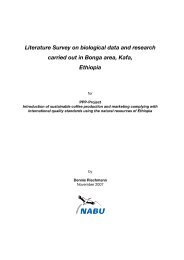Flora Biodiversity Assessment in Bonga, Boginda and Mankira Forest
Flora Biodiversity Assessment in Bonga, Boginda and Mankira Forest
Flora Biodiversity Assessment in Bonga, Boginda and Mankira Forest
Create successful ePaper yourself
Turn your PDF publications into a flip-book with our unique Google optimized e-Paper software.
highly disturbed forest). In general about 92 tree/shrub/liana species above 10 cm<br />
diameter are recorded <strong>in</strong> the three study sites. On site specific basis 46, 70 <strong>and</strong> 54<br />
tree/shrub/liana species are recorded <strong>in</strong> <strong>Mankira</strong>, <strong>Bonga</strong> <strong>and</strong> Bog<strong>in</strong>da respectively.<br />
With respect to density of trees above 10 cm diameter <strong>Bonga</strong> forest has the highest<br />
(590), followed by Bog<strong>in</strong>da forest (575) <strong>and</strong> <strong>Mankira</strong> forest (454). A total of 57<br />
species <strong>in</strong> <strong>Bonga</strong>, 36 species <strong>in</strong> Bog<strong>in</strong>da <strong>and</strong> 30 species <strong>in</strong> <strong>Mankira</strong> are recorded as<br />
regeneration. In the current survey 61.4 percent of trees hav<strong>in</strong>g dbh greater or equal to<br />
10 cm are represented as regeneration <strong>in</strong> <strong>Bonga</strong>. In Bog<strong>in</strong>da 52.8 percent of<br />
trees/shrubs hav<strong>in</strong>g 10 cm <strong>and</strong> above are recorded as regeneration, whereas <strong>in</strong><br />
<strong>Mankira</strong>, 43.5 percent of trees greater than 10cm dbh are represented as regeneration.<br />
Species such as Cordia africana are not registered as regeneration <strong>in</strong> any of the three<br />
forest areas. This is probably because the species is an early colonizer (Friis1992).<br />
Croton macrostacheys too, as a pioneer species (light dem<strong>and</strong><strong>in</strong>g), does not get<br />
adequate conditions for regeneration <strong>in</strong> a natural forest (Denich, 2006). But on road<br />
sides <strong>and</strong> wherever there is an open<strong>in</strong>g, Croton macrostacheys is well grown <strong>and</strong><br />
observed. Ficus species are also not represented <strong>in</strong> regeneration except F. palmata <strong>in</strong><br />
<strong>Mankira</strong>. In total, <strong>in</strong>clud<strong>in</strong>g regeneration, sapl<strong>in</strong>gs, herbaceous plants <strong>and</strong> grasses<br />
<strong>Bonga</strong> forest has the largest plant cover per ha (estimated to be more than 1,309,956).<br />
<strong>Mankira</strong> <strong>and</strong> Bog<strong>in</strong>da have lower number of flora density, each compris<strong>in</strong>g 510,120<br />
<strong>and</strong> 386,600, respectively.<br />
d) Endemic plants recorded <strong>in</strong> the current study <strong>and</strong> Schmitt C. B. (2006) are listed as<br />
follows: Erythr<strong>in</strong>a brucei, Milletia ferrug<strong>in</strong>ea, Solanecio gigas, Tiliacora troup<strong>in</strong>ii,<br />
Vepris da<strong>in</strong>elli, Aframomum corrorima, Brillantaisia grotanellii, Satureja paradoxa,<br />
Vernonia tewoldei, Mikaniopsis clematoides, Lippia adoensis, Clematis longicauda,<br />
Clematis longicauda, Pilea bambuseti ssp aethiopica, Pentas tenuis, Dorstenia<br />
soerensenii, Phyllanthus limmuensis <strong>and</strong> Cyrtorchis ehrythraeae.<br />
e) The result of this survey <strong>in</strong>dicates absence of constantly present species with<strong>in</strong> the<br />
three forest sites which leads to the conclusion that each forest has a heterogeneous<br />
species composition. Croton macrostachyus <strong>in</strong> <strong>Mankira</strong>, Milletia ferrug<strong>in</strong>ea <strong>in</strong> <strong>Bonga</strong><br />
<strong>and</strong><br />
2



